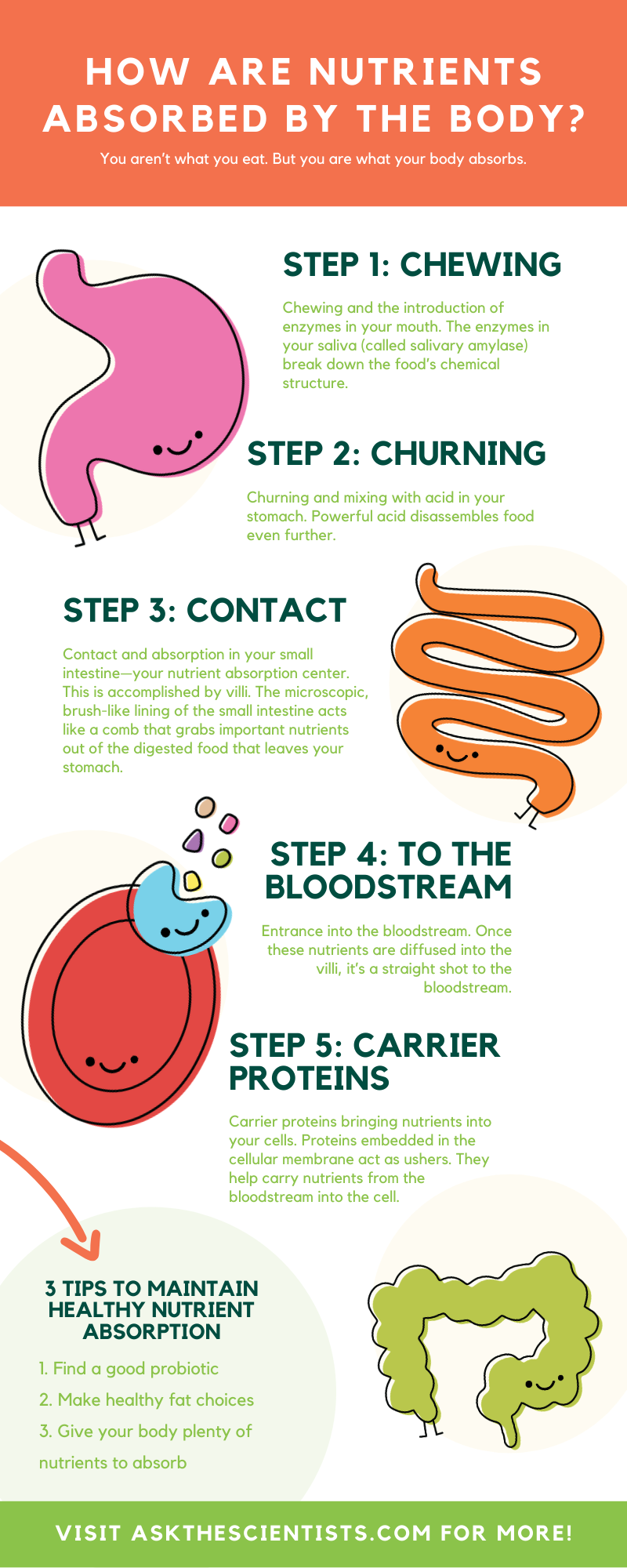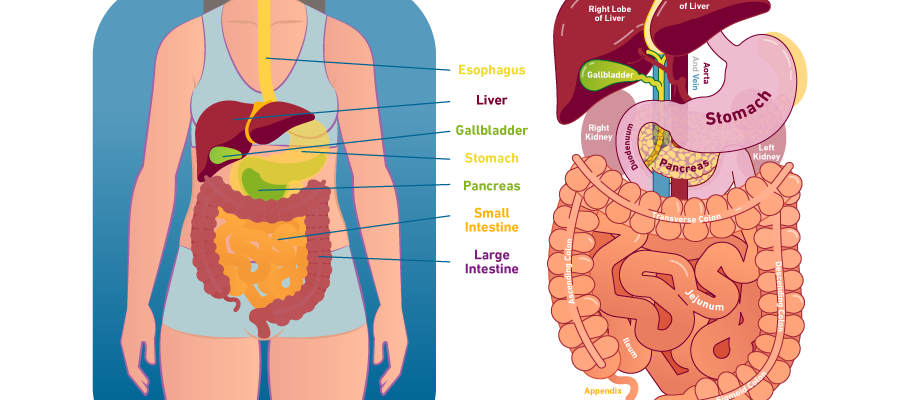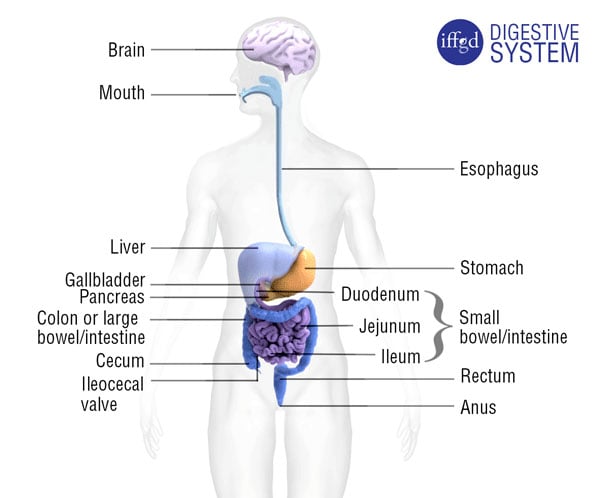Which Organ Absorbs Water and Vitamin K From Digested Food
These cells produce pepsin which breaks down proteins. Vitamin K is absorbed by the small intestine.

Your Guide To How Nutrients Are Absorbed By The Body Ask The Scientists
The Small Intestine The small intestine is made up of three different sections.

. Over 400 species of organisms live in the colon. How is water reabsorbed in the colon. Next the nutrients move into the bloodstream a process called absorption.
These tiny blood vessels transport absorbed nutrients. Digestion begins when you see smell feel or taste foods. Capillaries These tiny blood vessels transport absorbed nutrients.
The diagram at right shows part of a villus. Water diffuses in response to an osmotic gradient established by the absorption of electrolytes. Bacteria in your large intestine help break down remaining nutrients and make vitamin K.
Waste products of digestion including parts of food that are still too large become stool. Fill in the names of the organs that serve the functions listed below. Although the entire small intestine is involved in the absorption of water and lipids most absorption of carbohydrates and proteins occurs in the jejunum.
First the digestive system breaks food down into useful nutrients a process called digestion. Answer and Explanation. To survive your body must have a system for transforming food and drink into nutrients that it can absorb and use.
Parietal cells These cells produce hydrochloric acid HCl. These cells produce hydrochloric acid HCl. Mouthpharynx This organ produces enzymes that break down nutrients.
Now it is time to design and build your own digestive system. Chief cells These cells produce pepsin which breaks down proteins. Large intestine primarily absorbs water and products of bacterial digestion amino acids and vitamin B complex and vitamin K.
__________________ This organ absorbs water and vitamin K from digested food. Digestive System STUDY Flashcards Learn Write Spell Test PLAY Match Gravity large intestine Click card to see definition This organ absorbs water and vitamin K from digested food. Fill in the names of the organs that serve the functions listed below.
Large Intestine This organ absorbs water and vitamin K from digested food. Notably bile salts and vitamin B 12 are absorbed in the terminal ileum. The duodenum the jejunum and the ileum.
Digestion and Absorption of Nutrients. Saliva is responsible for chemical breakdown and allows next step swallowing. A villus is a tiny fingerlike projection in the wall of the small intestine.
But once fat-soluble vitamins are absorbed they enter the lymph channels and then head into the bloodstream. This organ produces enzymes that break down nutrients. Click again to see term 15 Previous Next Flip Space.
The hormonal and nervous systems signal the gastrointestinal tract that food is on the way. Absorption refers to the movement of nutrients water and electrolytes from the lumen of the small intestine into the cell then into the blood. _____ Parietal cell J.
Your small intestine also absorbs water with other nutrients. And the kidneys continuously regulate levels of water-soluble vitamins shunting excesses out of the body during urination. Large intestine is primarily involved in absorption of water.
It also absorbs water which remains in the undigested food. Almost all ingested food 80 percent of electrolytes and 90 percent of water are absorbed in the small intestine. Absorption of Water and Electrolytes Absorption of water occurs by osmosis.
Finally the leftover waste is removed from the body a process called elimination. Finally the leftover waste is removed from the body a process called elimination. Then the digested food is released into the small intestine where even more digestive enzymes are secreted by the liver gallbladder and pancreas as it prepares for its role in nutrient absorption.
In this article we will look at the digestion and absorption of carbohydrates protein and lipids. Now it is time to design and build your own digestive system. __________________ These tiny blood vessels transport absorbed nutrients.
The large intestine absorbs water from digested food. Vitamin K is absorbed by the small intestine. The large intestine absorbs water from remaining indigestible food matter and passes waste material from the body.
Pancreas This organ produces enzymes that break down nutrients. On the next tab. The large intestine absorbs water from digested food.
The small intestine contains millions of villi. First the digestive system breaks food down into useful nutrients a process called digestion. Normal bacteria in the intestine.
The intestinal absorption of vitamin K follows a well-established pathway that applies to most dietary lipids which includes bile salt- and pancreatic-dependent solubilization uptake of mixed micelles into the enterocytes the packaging of dietary lipids into CM and their exocytosis into the lymphatic system 2. Organ that absorbs water and vitamin K _____ Bile K. Most of the water is absorbed in the colon by diffusion.
In your large intestine more water moves from your GI tract into your bloodstream. Gizmo Warm-up The digestive system is a group of organs that does three things. Which organ absorbs water and vitamin k from digested food.
Normal bacteria in the intestine. However it also absorbs some ions and nutrients released by gut bacteria specially several vitamins eg vitamin K. This organ absorbs water and vitamin K from digested food.
__________________ This organ produces enzymes that break down nutrients. Once you swallow it travels to your stomach where hydrochloric acid and other digestive enzymes are dealing with solid parts shredding them and sends to small intestines where further digestion and nutrient absorption occurs. There are three carbohydrate products which are absorbed by the small intestine.
Enzyme that breaks down starches into simple carbohydrates 4. Whereas mineral ions are absorbed by the colon through active transport. Absorption of Different Nutrients.
The digestive systemis a group of organs that does three things. Next the nutrients move into the bloodstream a process called absorption. Read the descriptions of the large organs as well as those of the small organs on the next tab.

Human Digestive System Medical Knowledge Nursing School Tips Nursing Study

Chemical Digestion And Absorption A Closer Look Anatomy And Physiology

Your Digestive System Digestive Disease Center Temple Health

Comments
Post a Comment